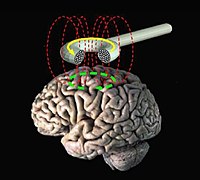
Photo from wikipedia
This study explored the modulatory effects of high-frequency transcranial random noise stimulation (tRNS) on visual sensitivity during a temporal attention task. We measured sensitivity to different onset asynchronies during a… Click to show full abstract
This study explored the modulatory effects of high-frequency transcranial random noise stimulation (tRNS) on visual sensitivity during a temporal attention task. We measured sensitivity to different onset asynchronies during a temporal order judgment task as a function of active stimulation relative to sham. While completing the task, participants were stimulated bilaterally for 20 min over either the TPJ or the human middle temporal area. We hypothesized that tRNS over the TPJ, which is critical to the temporal attention network, would selectively increase cortical excitability and induce cognitive training-like effects on performance, perhaps more so in the left visual field [Matthews, N., & Welch, L. Left visual field attentional advantage in judging simultaneity and temporal order. Journal of Vision, 15, 1–13, 2015; Romanska, A., Rezlescu, C., Susilo, T., Duchaine, B., & Banissy, M. J. High-frequency transcranial random noise stimulation enhances perception of facial identity. Cerebral Cortex, 25, 4334–4340, 2015]. In Experiment 1, we measured the performance of participants who judged the order of Gabors temporally imbedded in flickering discs, presented with onset asynchronies ranging from −75 msec (left disc first) to +75 msec (right disc first). In Experiment 2, we measured whether each participant's temporal sensitivity increased with stimulation by using temporal offsets that the participant initially perceived as simultaneous. We found that parietal cortex stimulation temporarily increased sensitivity on the temporal order judgment task, especially in the left visual field. Stimulation over human middle temporal area did not alter cortical excitability in a way that affected performance. The effects were cumulative across blocks of trials for tRNS over parietal cortex but dissipated when stimulation ended. We conclude that single-session tRNS can induce temporary improvements in behavioral sensitivity and that this shows promising insight into the relationship between cortical stimulation and neural plasticity.
Journal Title: Journal of Cognitive Neuroscience
Year Published: 2018
Link to full text (if available)
Share on Social Media: Sign Up to like & get
recommendations!